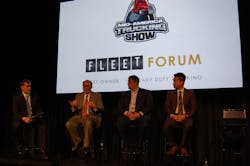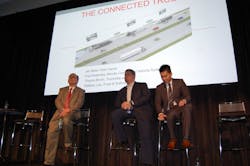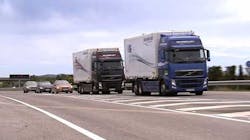The Connected Truck: We’ve only reached the tip of the iceberg
LOUISVILLE, KY. For those who believe that connected vehicles are still many years away, panelists on Fleet Owner’s The Connected Truck panel at today’s Fleet Forum ahead of the Mid-America Trucking Show disputed that notion.
Connected trucks in platoon operation could be on U.S. roadways within three years, they said, and moderator Jim Mele, editor-in-chief of Fleet Owner, noted that the reality of connected technologies is that trucking has been using them for nearly 25 years, starting back when the first telematics systems were installed.
But most people are more intrigued by autonomous trucks and their associated technologies.
“I think we will see platooning in the 2018-2019 timeframe,” said Fred Andersky, director, customer solutions-controls, for Bendix Commercial Vehicle Systems. “But, it will be in really [specialized] applications…how many fleets are really willing to platoon with a competitor? But, if you are a fleet that has a [group of] trucks that run the same routes” there may be opportunities to improve efficiencies through platooning.
Andersky was joined on the panel by Thayne Boren, general manager of Truckstop.com, and Wallace Lau, senior industry analyst-commercial vehicle research for Frost & Sullivan.
Lau agreed that Andersky’s timeframe was reasonable.
“It still comes down to operations,” he said. “I think as it matures and fleets see the benefits, it will gain, but I think it will start slow.”
What the panel showed attendees, though, is that the connected truck is not something the industry is unf“To realize the value of connectivity, we need to look at the infrastructure,” Andersky said. “Whether we want them or no, we need the government involved to improve infrastructure” and install the technologies needed for V2I communications.
The panel covered a range of topics related to connectivity, including vehicle maintenance opportunities through the ability to project when a component may fail and replace it beforehand. “[Prognostics] is the next step we’re moving into - fixing items before they even break,” Lau said.
Boren had a different take on how connected technologies and the connected truck can improve operations – one that many people gloss over.
“I see tremendous opportunity in parking. I see opportunity in fuel and where to fuel up, and the chance to optimize [repairs and the scheduling of repairs],” he said, adding that even small fleets (82% of Truckstop.com’s clients have between 1 and 5 trucks), may see benefits from connected trucks.
A level playing field
“I think the connected truck could level the playing field,” Boren noted. “The large fleets have the capital [to invest in connected technologies], but what if the 1-5 truck fleet could show service levels equal to the large fleets? Could there be increased opportunity for them?One concern for a more connected future, though, lies in the driver’s themselves. With a driver shortage of nearly 40,000 today, the question of whether platoons and truly autonomous trucks could turn off potential drivers is a real concern for many. Lau, though, suggested that may not be reality.
“The future truck is a connected truck, but it could be used to attract younger drivers by [letting] them connect with families,” he said.
To Andersky, the question is real and it’s the way the industry approaches it that will make the difference. “As we talk about autonomous trucks and trucks not needing drivers, we really have to think about the younger driver coming into the industry today,” he said. “Twenty-five years from now when they have kids and a mortgage and they are being tossed [aside], what is the message we want to be sending [today]?”
Another area of concern, albeit for manufacturers and component suppliers, is the amount of space available on the J1939 CAN Bus. According to Boren, a connected car could produce 1 GB of data per second, and “I don’t know of any network that can handle 1 GB a second.”
In a market that is expected to grow to $26.4 billion by 2025, said Lau, collecting that data, which is expected to be significantly increased on a heavy-duty truck vs. an automobile, and analyzing that data will be a tremendous challenge to overcome. That’s why Andersky predicts a “safety critical CAN” will be added to trucks at some point to assist with safety technologies.
That is a key, he adds, because in a platoon situation where two tractor-trailers are only about 50 ft. apart, a safety system failure could be disastrous.
The business case
When most people think of connected technologies, few tie them to business metrics. But there is ample opportunity there as well, the panelists said.
Lau presented a slide that displayed what the industry has achieved so far is just the “tip of the iceberg.”“That market is worth $3.5 billion today,” he said. But with only 46.1% of fleets using connected technologies (27% of which run Class 4 and up vehicles), there is still great growth opportunity, Lau noted.
The larger the fleet, he said, the more likely they are to use some form of connected technologies, including items such as advanced safety systems. Among small fleets, only 4.1% use such technologies, with that number growing to 32.2% of medium sized fleets and 55.4% of large fleets.
Among the areas that are in the tip right now are vehicle, driver and fuel management. But, he said other areas could be tapped with increased use of current and developing connected vehicle technologies. These areas include order management, driver behavior and training, prognostic and repair management, and warranty optimization. Going even deeper into the iceberg, areas include advanced driver assistance system integration, automated driving/platooning, usage based insurance and transport management.
Lau said that a great opportunity exists in the “mobile based brokering” model, i.e. the uberization of freight. With 30% of all miles traveled by U.S. trucking companies still empty miles, the amount of wasted fuel, productivity and asset utilization remains high. All this, he says, can lead to increased driver fatigue from unnecessary miles and increased congestion that results in lower productivity.
Boren sees connected technologies also increasing driver satisfaction.
“There’s an opportunity to look at your driver retention and not just who is not performing, but who you should be rewarding,” he said.
Advanced safety
Of course, the most prominent example of connected technologies today is the advanced safety systems Bendix and others are developing.
“Connectivity and the connected vehicle can be a really broad subject,” he said. “When the driver can sit back and take a nap or drink a coffee, that’s the ultimate, and to get to the ultimate, we’re talking [advanced safety systems].”
These started with ABS braking systems in 1996, he said, and have continued with stability control in 2004, radar and adaptive cruise control in 2009, collision mitigation and braking systems in 2011 and the addition of cameras and enhanced collision mitigation in 2015 “starting the first steps to sensor fusion,” Andersky said.
“In the future, what connectivity means is more information into the system,” he added.



